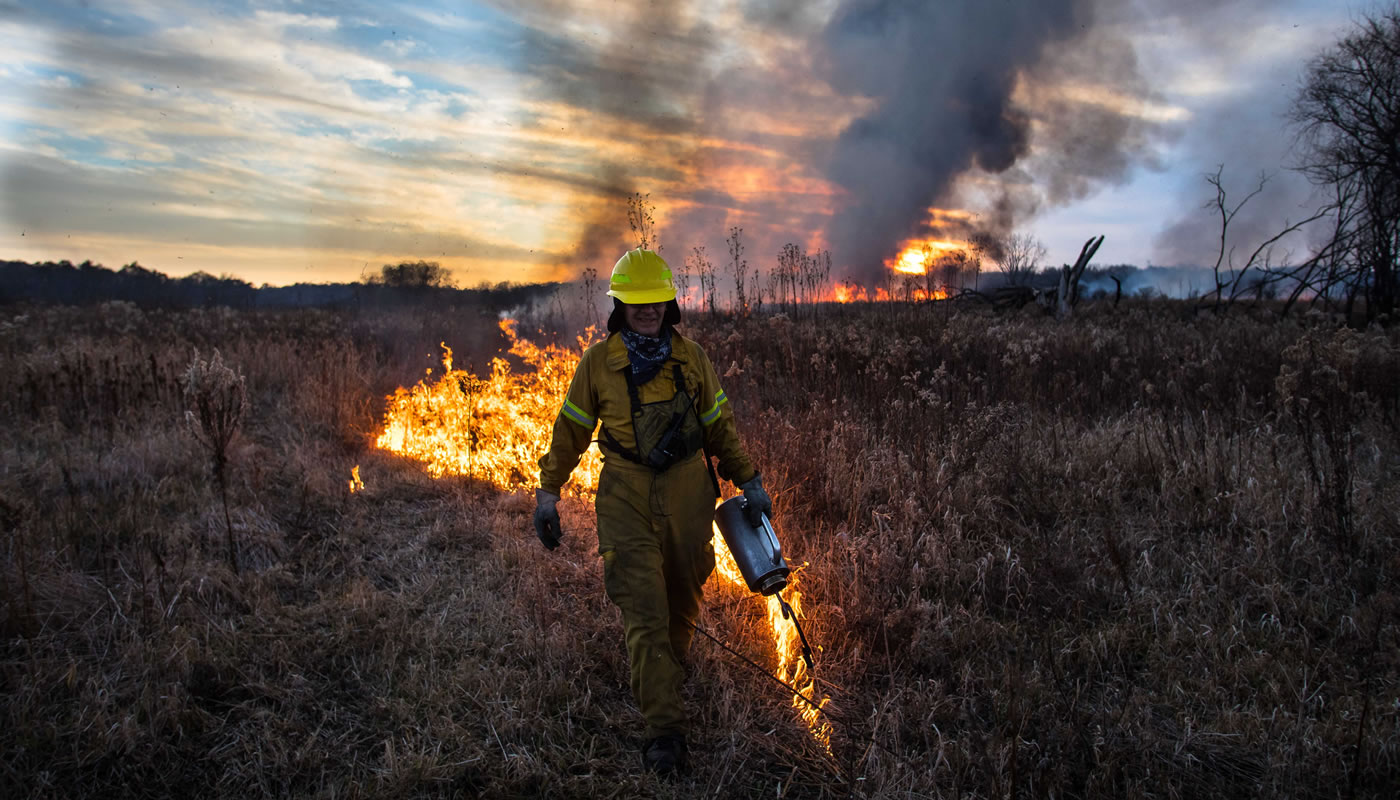Fall is more than changing leaves and end-of-the-year holidays. At the Forest Preserves, it’s time for employees, volunteers, contractors and partners to head out into woodlands, prairies and savannas for the fall 2018 prescribed burn season.
Elliot Medina, senior resource technician with the Resource Management Department, is a burn boss and a veteran of burns since his first job out of college. He answered some of our most burning questions about this important management technique.
You double majored in anthropology and environmental studies at Loyola University. Did you learn about prescribed burning in Cook County?
I knew our native plants and ecosystems co-evolved with fire and were dependent on it; however, I didn’t know the scale of what was going on in our local area. I just assumed you had to go out west or travel a little further from home to experience this ecological management technique. I didn’t realize the scope of the restoration efforts taking place in Cook County.
What is the benefit you’ve seen first-hand with burning prairies?
Learning about local prescribed burning and getting involved with the process reinforced my passion for prairies because I was witnessing the impact burning has in this ecosystem. There are some sites within the Forest Preserves that have been burned for the first time as part of this program. Within a year or two, we can already see native grasses and forbs returning. We can actually see a progression, and it’s all because of prescribed burning. Fire wakes up the native seed bank and native vegetation that lives at a site; it’s been suppressed for so long and beaten out by invasive species, but given just that little boost by fire it can begin to thrive again.
Burning for me is a challenge. I like examining all the variables including weather conditions, personnel and equipment limitations, to determine which site can be burned using the safest techniques. Each burn has its own puzzle to be solved.
What do you find most interesting or satisfying about conducting prescribed burns?
It’s also a time when we all come together and work as a team. We’ll have volunteers, Conservation Corps members, Forest Preserves crew members—all working together as a unit. All crew members must be tuned in to what’s happening on the ground and be prepared for potential changes.
As a burn boss, how do you ensure safety of the crew and public?
To ensure public safety, we start each morning by letting municipalities know we’ll be at a site, including the fire and police departments. We also communicate with the affected neighbors, Cook County commissioners, Illinois Environmental Protecting Agency and Cook County Department of Environment.
Warning signs are posted along roads and trails while conducting burns, and crew members are assigned to monitor trails and smoke output. We may station a mobile unit if we’re concerned about impacting a road.
We don’t close down a preserve, but we may close off part of a trail. The public is welcome to watch, and we’re constantly keeping a look out for any one that may be near the burn site. We communicate to the public what’s happening, and guide them to safe spots.
As for the crew, we start every morning with a pre-burn brief. This entails going over a map of the burn unit, known hazards, reviewing safe zones and escape routes, and the methods we will use to conduct the burn.
While performing the burn, we adhere to what is called “line of sight.” We never perform burns alone. Crew members are paired with a “burn buddy,” and maintain “line of sight” throughout the burn.
What is it about prescribed burning that is so beneficial to the landscape?
Our landscape has been neglected for so long, we’re now in a situation where it truly needs fire. By putting fire back on the ground and reintroducing it to areas that were historically burned, we’re bringing back an “old friend.” We are reuniting fire with the plants that really need it.
Why is prescribed burning performed twice a year?
Prescribed burning is conducted in spring and fall, when conditions are right. While burning, we want to be sure wildlife is dormant. We want to ensure reptiles, amphibians and insects are hibernating or overwintering in some capacity so the burn doesn’t negatively impact them. It’s also important that native, rare or easily impacted vegetation is dormant. Burning outside the growing season also means ground vegetation will be drier and result in less smoke output.
And some places shouldn’t undergo prescribed burning based on the season. For example, some sites could be susceptible to erosion, so we won’t burn those sites in fall when snowfall and spring melt will follow. Instead, we burn these sites in spring to minimize the amount of time soils are left bare and decrease the potential for erosion issues.
Tell us about a prescribed burn which you felt had the biggest impact.
I really like witnessing the first time a site undergoes prescribed burning. In the last couple years, we’ve had some really great spring burn seasons at Paul Douglas and Busse Woods. These are spots the Forest Preserves has wanted to burn for a long time. We put work in as far as other restoration activity, and to finally get a burn in feels good. It feels like we’ve accomplished a goal.
Interested in learning more about prescribed burns? Check out this blog post from November 2016.

